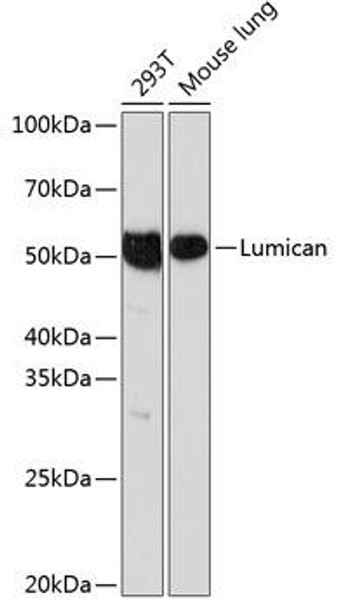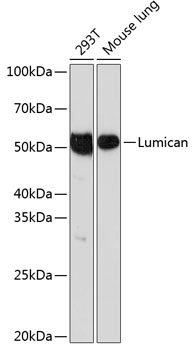Anti-Lumican Antibody (CAB11593)
- SKU:
- CAB11593
- Product type:
- Antibody
- Reactivity:
- Human
- Reactivity:
- Mouse
- Host Species:
- Rabbit
- Isotype:
- IgG
- Antibody Type:
- Monoclonal Antibody
- Research Area:
- Cell Biology
Frequently bought together:
Description
| 抗体名: | Anti-Lumican Antibody |
| 抗体コード: | CAB11593 |
| 抗体サイズ: | 20uL, 50uL, 100uL |
| 申し込み: | WB IHC |
| 反応性: | Human, Mouse |
| 宿主種: | Rabbit |
| 免疫原: | A synthesized peptide derived from human Lumican |
| 申し込み: | WB IHC |
| 推奨希釈: | WB 1:500 - 1:2000 IHC 1:50 - 1:200 |
| 反応性: | Human, Mouse |
| ポジティブサンプル: | 293T, Mouse lung |
| 免疫原: | A synthesized peptide derived from human Lumican |
| 精製方法: | Affinity purification |
| ストレージバッファ: | Store at -20°C. Avoid freeze / thaw cycles. Buffer: PBS with 0.02% sodium azide, 0.05% BSA, 50% glycerol, pH7.3. |
| アイソタイプ: | IgG |
| 順序: | Email for sequence |
| 遺伝子ID: | 4060 |
| Uniprot: | P51884 |
| セルラーロケーション: | |
| 計算された分子量: | 52kDa |
| 観察された分子量: | 50KDa |
| 同義語: | LDC, SLRR2D |
| バックグラウンド: | This gene encodes a member of the small leucine-rich proteoglycan (SLRP) family that includes decorin, biglycan, fibromodulin, keratocan, epiphycan, and osteoglycin. In these bifunctional molecules, the protein moiety binds collagen fibrils and the highly charged hydrophilic glycosaminoglycans regulate interfibrillar spacings. Lumican is the major keratan sulfate proteoglycan of the cornea but is also distributed in interstitial collagenous matrices throughout the body. Lumican may regulate collagen fibril organization and circumferential growth, corneal transparency, and epithelial cell migration and tissue repair. [provided by RefSeq, Jul 2008] |
| UniProt Protein Function: | LUM: a member of the small leucine-rich proteoglycan (SLRP) family that includes decorin, biglycan, fibromodulin, keratocan, epiphycan, and osteoglycin. In these bifunctional molecules, the protein moiety binds collagen fibrils and the highly charged hydrophilic glycosaminoglycans regulate interfibrillar spacings. Lumican is the major keratan sulfate proteoglycan of the cornea but is also distributed in interstitial collagenous matrices throughout the body. Lumican may regulate collagen fibril organization and circumferential growth, corneal transparency, and epithelial cell migration and tissue repair. [provided by RefSeq, Jul 2008] |
| UniProt Protein Details: | Protein type:Secreted, signal peptide; Secreted Chromosomal Location of Human Ortholog: 12q21.33 Cellular Component: extracellular matrix; extracellular region; extracellular space; fibrillar collagen; Golgi lumen; lysosomal lumen; proteinaceous extracellular matrix Molecular Function:collagen binding; protein binding Biological Process: axonogenesis; extracellular matrix organization and biogenesis; keratan sulfate biosynthetic process; keratan sulfate catabolic process |
| NCBI Summary: | This gene encodes a member of the small leucine-rich proteoglycan (SLRP) family that includes decorin, biglycan, fibromodulin, keratocan, epiphycan, and osteoglycin. In these bifunctional molecules, the protein moiety binds collagen fibrils and the highly charged hydrophilic glycosaminoglycans regulate interfibrillar spacings. Lumican is the major keratan sulfate proteoglycan of the cornea but is also distributed in interstitial collagenous matrices throughout the body. Lumican may regulate collagen fibril organization and circumferential growth, corneal transparency, and epithelial cell migration and tissue repair. [provided by RefSeq, Jul 2008] |
| UniProt Code: | P51884 |
| NCBI GenInfo Identifier: | 20141464 |
| NCBI Gene ID: | 4060 |
| NCBI Accession: | P51884.2 |
| UniProt Secondary Accession: | P51884,Q96QM7, B2R6R5, |
| UniProt Related Accession: | P51884 |
| Molecular Weight: | 38,429 Da |
| NCBI Full Name: | Lumican |
| NCBI Synonym Full Names: | lumican |
| NCBI Official Symbol: | LUM |
| NCBI Official Synonym Symbols: | LDC; SLRR2D |
| NCBI Protein Information: | lumican |
| UniProt Protein Name: | Lumican |
| UniProt Synonym Protein Names: | Keratan sulfate proteoglycan lumican; KSPG lumican |
| Protein Family: | Lumican |
| UniProt Gene Name: | LUM |
| UniProt Entry Name: | LUM_HUMAN |


